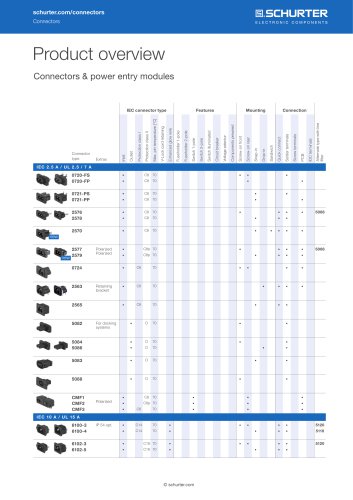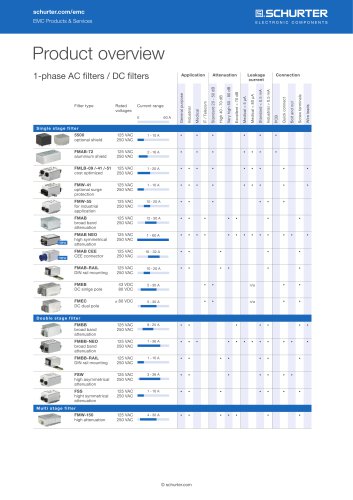 Website:
SCHURTER
Website:
SCHURTER
Group: SCHURTER
Catalog excerpts

Application Note schurter.com/downloads Balancing act Without battery balancing, the weakest cell in a multicell battery always determines the capacity of the entire system. However, since individual cells age differently, it is not possible to ensure that all cells have the same capacity, even with a conscientious selection. It needs different approaches. Lithium-ion batteries, like other battery types, are subject to a process of wear and tear during charging and discharging due to chemical changes. In the lithium-ion battery, the anode consists of a copper foil coated with carbon or a graphite compound. The cathode consists of a lithium compound. The electrolyte between the electrodes is a dissolved lithium salt. Depending on whether the electrolyte is liquid or solid, one speaks of lithium-ion or lithium-polymer batteries. The cells differ mainly in the cathode material, which can consist of cobalt, manganese, nickel-cobalt, nickel-cobalt-manganese (NKM), iron phosphate or titaniumate. The various cathode materials cause different energy densities, power densities, nominal voltages and possible charging cycles. Smooth charging The so-called IU charging method, which is used for such cells, works with constant current and constant voltage (Constant Current = CC, Constant Voltage = CV). In this procedure, the batteries are first charged with a constant current. This limits the charging current, which prevents this to be too high. Constant current charging continues until the final charge voltage is reached. Afterwards, charging is continued with constant voltage, so that the final charge voltage cannot be exceeded. The charging current decreases with increasing charge. Like the lifespan, the charging time also depends on a number of factors, with higher charging capacities, above all on the temperature. Short charging and discharging times have a negative effect on the electrode material, so that the lifespan and number of cycles are shortened. Smooth charging and discharging increases the lifetime of a lithium-ion cell massively! Lithium plating Charging lithium-ion cells at high charging currents or low temperatures can lead to the damaging effect of lithium plating. Lithium ions preferably deposit on the anode surface instead of intercalating between the layers of graphite. This effect results in significant losses of performance, durability and safety. In extreme cases, lithium plating can even lead to a short circuit or, as metallic lithium is quickly flammable, to a fire. Depending on the quality and design of the battery, 500 to more than 1000 charging cycles are common. A battery is considered worn when less than 80% of its original capacity is left. The Problem So-called clusters or battery packs generally consist of several single cells or cell blocks connected in series to increase the nominal voltage. Due to production Circuit Protection
Open the catalog to page 1
Application Note schurter.com/downloads [1] High discharging stressleads to reducedlifetime [2] High charging stressleads to reducedlifetime and ageing there are fluctuations in the capacity, internal resistance and other parameters of these cells. The weakest cell determines how much is loaded and how much may be unloaded. In the practical use of multicellular batteries connected in series, this leads to the fact that the cells are charged and discharged differently in series. Critical deep discharge or overcharge occurs in the network or when individual cells overcharge and exceed the...
Open the catalog to page 2
schurter.com/downloads They must allow maximum charge and discharge currents to pass with minimal losses. Switching on and off, accelerating - cyclic resistance is also indispensable. Customized fuses However, the biggest enemies of battery packs are overtemperature, short-circuits and pulsed overcurrents. Depending on the design and purpose of the high-performance battery pack, the focus must be placed on protection against overcurrent and/or more on temperature. In most cases, however, several potential problems come together at the same time. In practice, this means that...
Open the catalog to page 3All SCHURTER catalogs and technical brochures
-
FMAD NEO
6 Pages
-
SUSTAINABILITY REPORT 2022
37 Pages
-
THS
5 Pages
-
TTS
4 Pages
-
Product News
4 Pages
-
FMAB NEO
12 Pages
-
FPG1
4 Pages
-
FMAB HV
6 Pages
-
UMT-W
4 Pages
-
OGN
3 Pages
-
0712
3 Pages
-
CPS
7 Pages
-
DG12
10 Pages
-
4751
4 Pages
-
FMAD CP
4 Pages
-
4783
4 Pages
-
EF11
8 Pages
-
PFRY
4 Pages
-
PFRA
6 Pages
-
PFMF
4 Pages
-
PFHT
3 Pages
-
PFDF
3 Pages
-
Company Profile
20 Pages
-
Voltage Selector
1 Pages
-
Resettable Fuses
1 Pages
-
6051.2067
3 Pages
-
6051.2068
3 Pages
-
Suppression Chokes DKIH-1
6 Pages
-
4797-5
4 Pages
-
6051.2063
3 Pages
-
6051.2061
3 Pages
-
6051.2015
3 Pages
-
3-108-993
2 Pages
-
3-100-361
3 Pages
-
GP21
3 Pages
-
AURORA Complete Solutions
2 Pages
-
FMER SOL
10 Pages
-
CMF2, CMF5
3 Pages
-
CDS1
5 Pages
-
DKIH-3
6 Pages
-
4710-5
5 Pages
-
Touchkit
3 Pages
-
USN 1206
3 Pages
-
FPBB RAIL
7 Pages
-
DD14
8 Pages
-
VAC19KS
3 Pages
-
UMK 250
4 Pages
-
TA35 Rocker 1Pole
6 Pages
-
4761
3 Pages
-
4732
4 Pages
-
FUS
3 Pages
-
DKIH
6 Pages
-
FSO
2 Pages
-
CSO
3 Pages
-
CMF1, CMF4
3 Pages
-
FMAC NEO
5 Pages
-
MSM DP 30
8 Pages
-
PSE AE 16
3 Pages
-
MSM LA CS 22
7 Pages
-
MSM LA CS 19
6 Pages
-
PSE AE 30
5 Pages
-
PSE EX 16
5 Pages
-
PSE EX 19
5 Pages
-
PSE NO 19
6 Pages
-
PSE NO 16
6 Pages
-
PSE EX 22
5 Pages
-
PSE NO 27
6 Pages
-
PSE NO 24
6 Pages
-
PSE NO 22
8 Pages
-
PSE IV 16
6 Pages
-
PSE HI 22
6 Pages
-
PSE NO 30
7 Pages
-
PSE M22 IV
7 Pages
-
MCS ES 18
3 Pages
-
MCS ES 22
3 Pages
-
6051.2094
3 Pages
-
6051.2093
3 Pages
-
6051.2078
3 Pages
-
6051.2077
3 Pages
-
6051.2070
3 Pages
-
6051.2072
3 Pages
-
6051.2071
3 Pages
-
6051.2037
2 Pages
-
6051.2030
3 Pages
-
6051.2032
3 Pages
-
6051.2031
3 Pages
-
6051.2027
3 Pages
-
3-107-570
2 Pages
-
3-107-569
2 Pages
-
VAC13KS
4 Pages
-
DD21
5 Pages
-
DD11
5 Pages
-
DF11
6 Pages
-
DG11
7 Pages
-
typ_6051.2016
3 Pages
-
typ_6051.2008
3 Pages
-
typ_6051.2009
3 Pages
-
typ_6051.2001
4 Pages
-
typ_6051.2007
3 Pages
-
typ_6051.2003
3 Pages
-
typ_6051.2004
3 Pages
-
typ_4762
3 Pages
-
typ_3-101-514
3 Pages
-
typ_3-101-501
3 Pages
-
typ_3-100-528
3 Pages
-
typ_3-100-734
3 Pages
-
typ_3-100-526
3 Pages
-
typ_3-100-523
3 Pages
-
typ_3-100-524
3 Pages
-
typ_3-100-527
3 Pages
-
typ_3-100-522
3 Pages
-
typ_3-100-356
3 Pages
-
typ_3-100-355
3 Pages
-
typ_3-100-354
3 Pages
-
Application Note Surge
2 Pages
-
White Paper IP Protection
2 Pages
-
SWA2
2 Pages
-
PB 1021
2 Pages
-
TM12-111
6 Pages
-
PTS
4 Pages
-
Piezo Keypads
4 Pages
-
PB 1011
2 Pages
-
FMAD CEE
3 Pages
-
White Paper Data Center
4 Pages
-
White Paper SPICE library
4 Pages
-
White Paper Cord retention
4 Pages
-
SCHURTER and ESA cooperation
2 Pages
-
Efficient EMC Solutions
8 Pages
Archived catalogs
-
Product News
4 Pages
-
SCHURTER Company Profile
10 Pages
-
PFDF
3 Pages
-
PFHT
3 Pages
-
PFUF
3 Pages
-
SCHURTER Renewable Energies
6 Pages
-
SCHURTER Product News
4 Pages
-
DKFP
5 Pages
-
FMAD RAIL
3 Pages
-
FMAC RAIL
3 Pages
-
FMBD NEO
6 Pages
-
FMAC SINE DCL
4 Pages
-
FMAC SINE
4 Pages
-
FMAB RAIL
3 Pages
-
FMBB NEO
11 Pages
-
FMBB RAIL
3 Pages
-
5120
10 Pages
-
SMD-FTT
1 Pages
-
OMZ 125
1 Pages
-
4840.2200
2 Pages
-
6051.5003
2 Pages
-
6000.0224
2 Pages
-
6051.2030
2 Pages
-
6051.2003
2 Pages
-
FLBB
2 Pages
-
4741
2 Pages
-
P685
2 Pages
-
KE
4 Pages
-
GSF2
4 Pages
-
GSF1
5 Pages
-
Felcom 64
4 Pages
-
6135
5 Pages
-
KG-Bowdencable
4 Pages
-
KD-Bowdencable
4 Pages
-
DC21
3 Pages
-
1074
4 Pages
-
DC11
5 Pages
-
CMF3, CMF6
2 Pages
-
PFNF
3 Pages
-
ESO 10.3x38
1 Pages
-
SHT 6.3x32
1 Pages
-
Product Overview Switches
2 Pages
-
KEB2
1 Pages
-
New product: 6610
3 Pages
-
New product: UMZ 250
3 Pages
-
New product: CSO
2 Pages
-
New product: UST 1206
2 Pages
-
New product: UMF 250
3 Pages
-
New product: UMT-H
3 Pages
-
TA35 Rocker 2Pol
8 Pages
-
SCHURTER range at a glance
236 Pages
-
ASO / FSO
8 Pages
-
Flyer UMT 250 / UMZ 250
8 Pages
-
SCHURTER - Flyer MSM CS
2 Pages
-
Varistors
40 Pages
-
Flyer MGA-S
6 Pages




























































































































































































































































